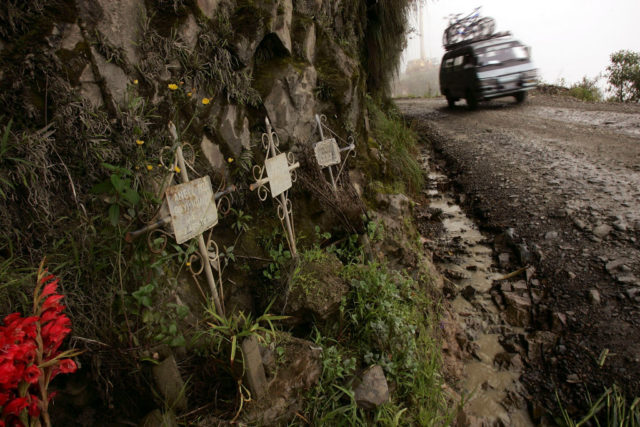Connecting the Amazon Rainforest to Bolivia’s capital city, Death Road is infamous for the tragedies that have occurred along its expanse. Its narrow width, uneven dirt surface and a lack of safety implements have led many to fall to their demise. While that should make people want to avoid the area, this reputation has actually led to a booming tourist industry.
Death Road claimed hundreds of lives each year

The history of death road dates back to the Chaco War of 1932-35. A conflict between Bolivia and Paraguay for control over the northern part of the Gran Chaco region concluded with the majority of the disputed land being awarded to the latter. During the war, Paraguayan prisoners constructed the road, which remained in a relatively unkempt and basic state over the subsequent decades.
Stretching from the Bolivian capital of La Paz to the hilltop town of Coroico, the 40-mile roadway is officially known as the North Yungas Road. Only 10 feet wide, it’s made completely of dirt and has no guardrails separating it from the 2,000-foot drop to the ground below. If that wasn’t nerve-wracking enough, the road’s altitude means it’s constantly shrouded in cloud and fog, and the area’s tropical climate means there’s frequent rain.
All of this means the dirt making up the road’s surface becomes incredibly muddy and treacherous to cross. That’s why it likely comes as no surprise that the Inter-American Development Bank dubbed it the “Most Dangerous Road in the World.” During the height of its use, between 200 and 300 drivers perished annually after going over the edge. As well, at least 18 cyclists have died along the road since 1998.
Among the most notable incidents to occur along Death Road were a Jeep accident in December 1999, which resulted in the deaths of eight Israeli travelers, and the veering off of a bus filled with over 100 passengers in July 1983. The latter is considered to be the worst road accident ever to occur in Bolivia.
Modernization efforts led to a decrease in deaths

Over the span of 20 years, the Bolivian government worked on a more modern roadway to replace Death Road. Located along a nearby mountain range, Route 3 is a two-lane, paved roadway with modern drainage systems and bridges. It’s well-maintained and is surrounded by guardrails, meaning the chances of a driver going over the edge are slim.
The majority of those traveling between La Paz and Coroico now opt to travel along Route 3 versus Death Road. That being said, there are still the brave few who take the risk. Along the way, they’re reminded of the roadway’s tragic history, as people have put up wooden crosses along the dirt expanse to memorialize those who went over the edge.
Death Road has become a popular tourist attraction

Given the reputation Death Road has earned itself, the roadway has become a popular tourist attraction. It’s believed around 25,000 tourists visit it each year, with a number of tour operators taking advantage of the continued interest and intrigue. Its reputation is such that the road has been featured in a number of television shows, such as Top Gear (2002-present).
The road’s location along the mountainside has meant that the majority of tours offered are geared toward mountain bikers and casual cyclists. However, there are others who offer guided tours and information regarding the area’s history. Given it’s still an open road, the expanse continues to see use in the transportation of equipment and goods, albeit on a smaller scale.
From a dangerous expanse to a wildlife haven

Following the efforts to construct a more modern roadway nearby, vehicle traffic along Death Road dropped by an estimated 90 percent. While this has most certainly saved hundreds of human lives, the decline in traffic has allowed native wildlife to return to the area.
For those unaware, the Yungas is an incredibly biodiverse region in South America, serving as a transition zone between the Amazon Rainforest and the Andes mountain range. As a result of its humid, tropical climate, the expanse is home to a wide array of wildlife. However, the noise, pollution and congestion caused by the frequent traffic along Death Road meant animals tended to avoid the area.
During a recent study, biologists and wildlife experts used cameras to catch an unbelievable scene. Over the course of their research, they captured footage of 16 medium and large animal species, along with 94 types of wild birds. Among those spotted included the oncilla, the white-throated quail-dove, the Andean guan, the dwarf brocket and the mountain paca.
More from us: Archaeologists Discover Remarkably Well-Preserved 2,000-Year-Old Roman Ship
As more creatures return to Death Road, the possibility of the area’s reputation changing becomes more likely. Rather than being the location where tourists and civilians alike plunge to their deaths in tragic accidents, the road will help breathe new life into the wildlife populations of the Yungas.
